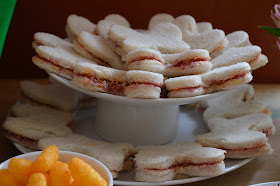I have been so encouraged to hear from some of you that this blog has inspired you to go and buy a sewing machine. So I have discovered this darling project that is a nice easy project for a beginner, and yet is one of the most satisfying things I have ever made.
As it is nearly mother's day I hope this may motivate some of you to dust off your sewing machines and make something beautiful for your mum (much nicer than chocolates!) or just keep it for yourself!

Primarily this project is about origami rather than sewing. The precision in folding will ensure the success of your final cushion so take your time folding and ironing.
You can see in this picture I have made a 48cm square using cardboard and then cut out a piece of white cotton 3cm bigger on each side. I then folded the corners and then the edges and ironed over them all to make a crease.
Once I ironed all the edges I removed the cardboard and folded the square in half both ways ironing each time. Once opened the fabric should have four creased squares.
 Now fold each corner into the middle of the fabric and iron each of them down firmly.
Now fold each corner into the middle of the fabric and iron each of them down firmly.I now cut a square piece of patterned fabric to fit inside the folded triangles.
Lay it inside and fold the triangles back over the top so you can't see it.

Using my sewing machine (though you could hand sew it) I sewed a 5 cm line from the tip of one triangle to the opposite one, and then on the two adjacent ones. This is
through all layers of the fabric
On this picture you can just see the lines in the shape of a cross from top to bottom and from left to right.
Now I used four triangles of coloured material (I have used four different patterns, but you could use the same) and laid them on the top of the triangles I folded over.
 I have left a small amount of the white triangle visible which I now fold back over the patterned fabric to act as a border. As I pinned the middle of each line through all the layers of fabric it naturally fell into a gentle curve revealing a leaf shaped window to the fabric below.
I have left a small amount of the white triangle visible which I now fold back over the patterned fabric to act as a border. As I pinned the middle of each line through all the layers of fabric it naturally fell into a gentle curve revealing a leaf shaped window to the fabric below.Here you can see that all the lines have been pinned using only one pin on each one.
Now I began sewing with my machine. You could do this by hand, but if you do have a machine it is very satisfying and really not too hard.
 Start in the middle of the cushion and sew down the white border you have created. It really doesn't matter if you stick to the middle or the edge of your border.
Start in the middle of the cushion and sew down the white border you have created. It really doesn't matter if you stick to the middle or the edge of your border.
Once I finish all the lines I trimmed off the edges of the cushion and cut off all the loose bits of cotton thread.
Don't worry about all the messy bits of cotton in the middle where you have begun each line, now you choose a big bold button to sew in the middle of the cushion to make it look truly sumptuous.
Now all I had to do was make a back cover for my cushion.
As you know I like to keep it easy and so I use the envelope technique which uses two pieces of fabric both slightly shorter than the width of the cushion. So long as the outside layer (inside when you are sewing it) has a hemmed edge you will not need to attach any buttons or zips.
Here you can seen I have laid the cushion cover faced upwards, then the hemmed layer faced downwards and the final back layer also faced downwards.
Pin it all together and then sew around the lot.
Once finished you can turn the whole thing inside out through the envelope and put your cushion cover on your cushion.
 These cushions took me 35 minutes to make and were tremendously satisfying.
These cushions took me 35 minutes to make and were tremendously satisfying.They are presents for my fabulous mother and my wonderful mother-in-law.
Happy Mother's Day, I love you both.






























